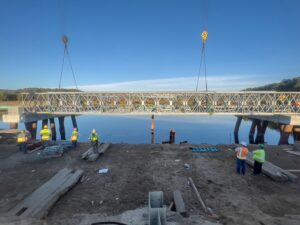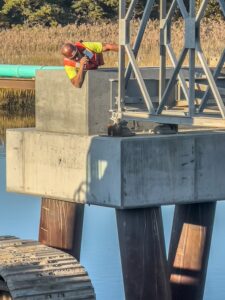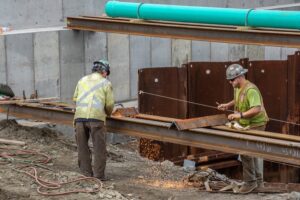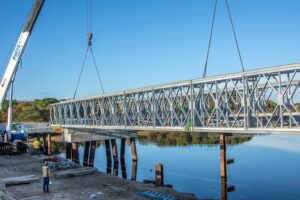WELLFLEET — The construction site where Chequessett Neck Road crosses the Herring River was bustling on Oct. 24 as pallets of enormous metal squares called truss panels arrived on trucks. The first 100-foot span of panels went into place two days later. Three similar spans will soon be added to form the 320-foot superstructure of the temporary bridge over the river, representing a major milestone in the ongoing Herring River Restoration Project.

The arrival of the spans puts the project “one step closer to getting the temporary bridge in,” said Wes Stinson, the owner’s representative for the Herring River Restoration Project, acting on behalf of the engineering firm Environmental Partners. Once the bridge is in, he said, “we can get going in earnest on the replacement of the dike.”
The Herring River Restoration Project is a $70-million collaboration between the town of Wellfleet and the National Park Service to restore tidal flow to the Herring River, a once-thriving estuary that has been slowly degraded since a dike was built across its mouth in 1909.
One of the first steps is to replace the dike with a bridge and tidal gates and begin allowing more salt water to flow back into the river. But first, since the road on top of the dike is the only way for some Wellfleet residents to reach town, a temporary bridge is being built across the river.

Over the next four weeks, the construction workers, who are subcontracted by the Acton-based MIG Corp., will finish bolting together the bridge spans and place them atop the piers that they constructed over the summer.
The spans will then be paved to connect to the rest of Chequessett Neck Road. MIG will also be installing conduits to allow utilities to pass down the temporary bridge. There will be a temporary pedestrian walkway along its east side.

Stinson estimated the temporary bridge will be drivable by the end of the year. The bridge will have just one lane with a traffic light at either end to manage the flow of traffic.
Before the Chequessett Neck dike was built in 1909, the Herring River was a “vibrant, regionally important estuary,” according to the Division of Ecological Restoration (a division of the state Dept. of Fish and Game) that served as a crucial migratory pathway for river herring, which travel from the ocean to freshwater ponds to breed.
When the dike was built, however, it blocked tidal flow and turned the estuary’s brackish water fresh, killing off saltwater plants, degrading the ecosystem, and preventing the herring from returning upriver to spawn. Although one reason the dike was built was to control mosquito populations, the dammed river proved to be a fertile breeding ground for the insects — a fact locals were reminded of when a storm-driven overwash at Duck Harbor led to a significant mosquito outbreak in the summer of 2021.

Once the temporary bridge is in place, MIG will begin in earnest to construct the permanent bridge and the series of tidal gates that will control saltwater flow into the estuary. Stinson estimates the construction will be completed by the spring of 2025.
The arrival of the bridge “represents decades of science and advocacy and collaboration,” said Christa Drew, executive director of the nonprofit Friends of Herring River.
The idea of restoring the river has been around since at least 1972, when the Wellfleet Conservation Commission first proposed that the dike be replaced.

While the work on the Chequessett Neck Road bridge is underway, another contract is being designed for restoration work further upriver. That portion of the restoration project involves installing culverts and water-control structures and raising low lying roads, like High Toss and Pole Dike, to accommodate the increased tidal flow.
Eventually, a restored brackish ecosystem will allow herring to travel all the way from the ocean to Herring, Higgins, and Gull ponds to spawn.



